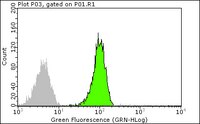04-775 Sigma-AldrichAnti-Ha-Ras Antibody, clone MC57, rabbit monoclonal
Detect Ha-Ras using this Anti-Ha-Ras Antibody, clone MC57 validated for use in WB.
More>> Detect Ha-Ras using this Anti-Ha-Ras Antibody, clone MC57 validated for use in WB. Less<<Recommended Products
Overview
| Replacement Information |
|---|
Key Specifications Table
| Species Reactivity | Key Applications | Host | Format | Antibody Type |
|---|---|---|---|---|
| H, M, R | WB | Rb | Culture Supernatant | Monoclonal Antibody |
| References |
|---|
| Product Information | |
|---|---|
| Format | Culture Supernatant |
| Control |
|
| Presentation | Cultured supernantant containing 0.05% sodium azide. |
| Quality Level | MQ100 |
| Applications | |
|---|---|
| Application | Detect Ha-Ras using this Anti-Ha-Ras Antibody, clone MC57 validated for use in WB. |
| Key Applications |
|
| Physicochemical Information |
|---|
| Dimensions |
|---|
| Materials Information |
|---|
| Toxicological Information |
|---|
| Safety Information according to GHS |
|---|
| Safety Information |
|---|
| Packaging Information | |
|---|---|
| Material Size | 100 µL |
| Transport Information |
|---|
| Supplemental Information |
|---|
| Specifications |
|---|
| Global Trade Item Number | |
|---|---|
| Catalog Number | GTIN |
| 04-775 | 04053252677106 |
Documentation
Anti-Ha-Ras Antibody, clone MC57, rabbit monoclonal SDS
| Title |
|---|
Anti-Ha-Ras Antibody, clone MC57, rabbit monoclonal Certificates of Analysis
| Title | Lot Number |
|---|---|
| Anti-Ha-Ras, clone MC57 - 2448455 | 2448455 |
| Anti-Ha-Ras, clone MC57 - 2278561 | 2278561 |
| Anti-Ha-Ras, clone MC57 - 3429402 | 3429402 |
| Anti-Ha-Ras, clone MC57 - 3506453 | 3506453 |
| Anti-Ha-Ras, clone MC57 - 3824796 | 3824796 |
| Anti-Ha-Ras, clone MC57 - 4044751 | 4044751 |
| Anti-Ha-Ras, clone MC57 - NG1905692 | NG1905692 |
| Anti-Ha-Ras, clone MC57 - NRG1674334 | NRG1674334 |
| Anti-Ha-Ras, clone MC57 -2628318 | 2628318 |
| Anti-Ha-Ras, clone MC57 Monoclonal Antibody | 2989483 |








